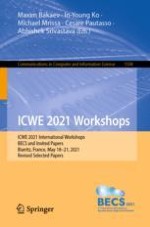2022 | Buch
ICWE 2021 Workshops
ICWE 2021 International Workshops, BECS and Invited Papers, Biarritz, France, May 18–21, 2021, Revised Selected Papers
herausgegeben von: Maxim Bakaev, Prof. In-Young Ko, Michael Mrissa, Prof. Cesare Pautasso, Abhishek Srivastava
Verlag: Springer International Publishing
Buchreihe : Communications in Computer and Information Science
